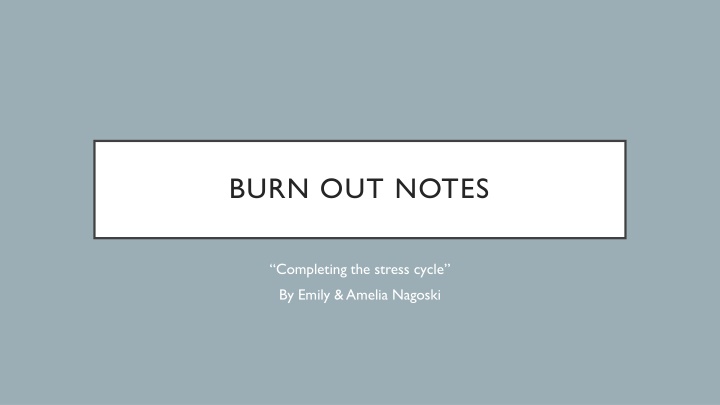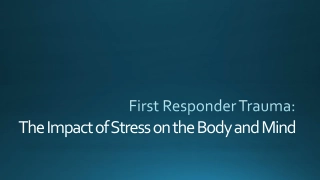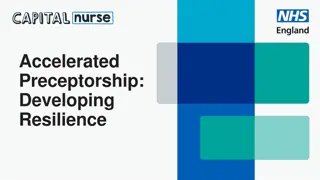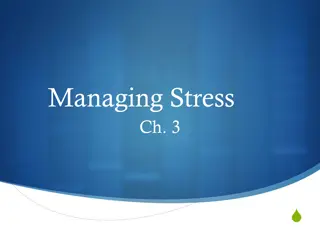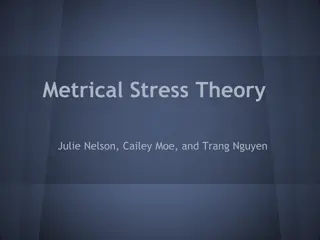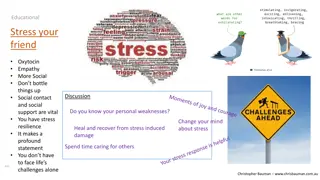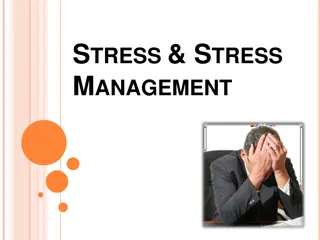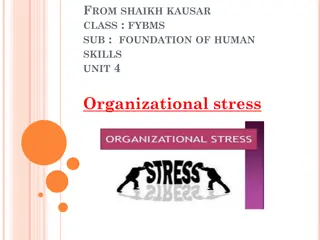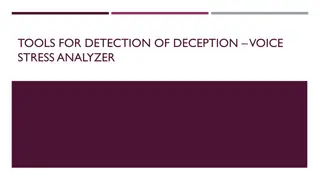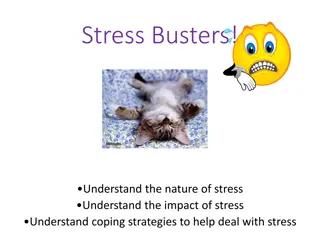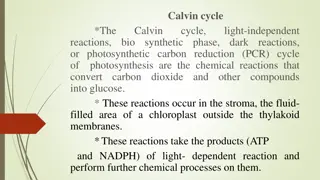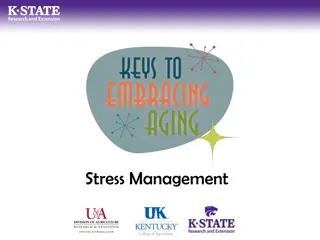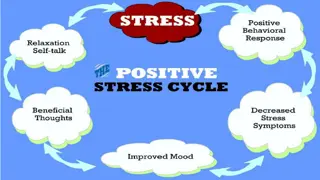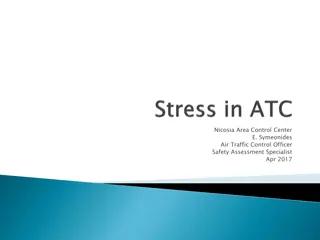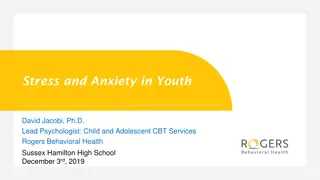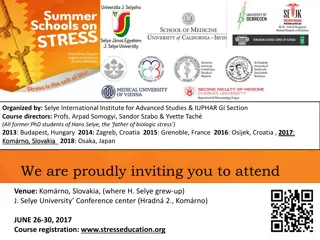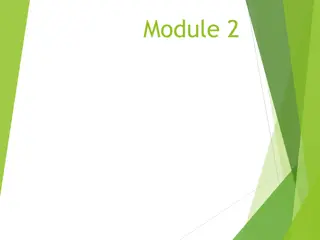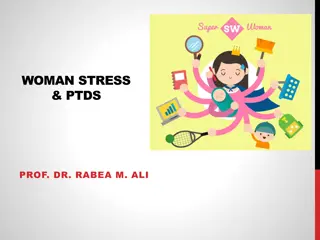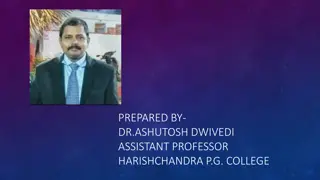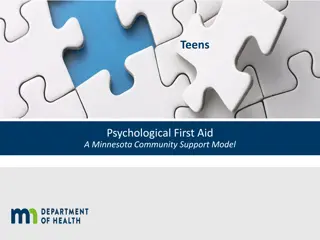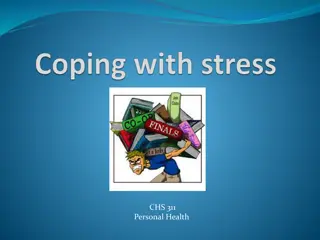Completing the Stress Cycle for Well-being
Stress, whether fight, flight, or freeze, has a cycle that needs completion. Addressing stress before stressors, engaging in various ways to complete the cycle, and prioritizing rest are essential for optimal health. Explore science-based methods to reduce stress, including exercise, mindful breathing, positive social interactions, laughter, affection, creativity, and more.
Download Presentation

Please find below an Image/Link to download the presentation.
The content on the website is provided AS IS for your information and personal use only. It may not be sold, licensed, or shared on other websites without obtaining consent from the author.If you encounter any issues during the download, it is possible that the publisher has removed the file from their server.
You are allowed to download the files provided on this website for personal or commercial use, subject to the condition that they are used lawfully. All files are the property of their respective owners.
The content on the website is provided AS IS for your information and personal use only. It may not be sold, licensed, or shared on other websites without obtaining consent from the author.
E N D
Presentation Transcript
BURN OUT NOTES Completing the stress cycle By Emily & Amelia Nagoski
MAIN POINTS Stress (whether its fight, flight or freeze) has a cycle that needs completing before our body recognizes its safe to rest. We need to deal with the STRESS before the STRESSORS There are 7 different ways to complete the cycle The monitor measures the effort we put in vs put out Human Giver Syndrome is the contagious belief that you have a moral obligation to give every drop of your humanity in support of others no matter the cost to you Rest is VITAL
STRESS Fight sympathetic nervous system (means with feeling) Flight sympathetic nervous system (means with feeling) Freeze- last ditch stress response parasympathetic nervous system (means beyond emotion) Body perceives a threat and stimulates adrenal glands to realease adrenaline and noradrenaline. Feelings: Irritated, annoyed, frustrated, angry Heart rate raised, blood vessles dilate to serve the muscles and constrict the digestion. Increased breathing, increase glycogen, pupils dilate. All better to fight. Senses heightened, memory just now and relevant, others organs get supressed. (immune, reproductive function, muscles and building) After threat is gone, it can take 20-60mins to return to normal. IF THE CYCLE IS COMPLETE. Body perceives a threat Feelings: unsure, worried, anxious, scared, frightened, terrified Body realises the best way out of the stress is to do nothing/play dead. Feelings: Shut down, numb, immobilised, disconnected Heart rate drops, physical immobility (literally freeze), muscle tension, increase is visual perception, dissociation. Heart rate raised, blood vessles dilate to serve the muscles and constrict the digestion. Increased breathing, increase glycogen, pupils dilate. All better to run away. After threat is gone, it can take 20-60mins to return to normal. IF THE CYCLE IS COMPLETE. After threat is gone, body can tremble, shake or shudder- body getting rid of adrenaline built up. The Feels its normal healthy part of completing the cycle.
SCIENCE BASED WAYS TO REDUCE STRESS Way to break cycle 1) Exercise: Tells our body You have survived the threat, your body is now safe How The most efficient way to break the cycle. Realises endorphins, cheats your body to thinking it has dealt with the stressor. What All exercise but if at a desk Tense for 20 seconds, shake and breathe out. All exercises- walking, jogging, dancing, hit, strength, boxing etc In for 5, hold for 5, out for 10. Repeat. 1) Breathing: Tells our body to calm down, threat has gone Positive social interaction: Tells our body the world is a safe place Good for not high stress or to lower it a little. 1) Small talk actually has links to higher wellbeing. It shows our body that the world and people around us are nice and safe. Regulates emotions Small talk, say hi to someone walking dog, or in a caf , smile at someone. 1) Laughter: Increasing relationship satisfaction Affection: Deep with a loving presence or higher power Deep and real laughing 1) Shows your body you are safe. Social bonds. 20 second hug both on balance. Or a 6 second kiss. Pet your cat or dog or pet! Walking your dog gets both! Or spiritual. Full on messy cry. Might not change the stressor, but you close the cycle! Anything! Dance, acting, painting, sculpture, drawing, writing etc etc 1) Crying Gets out stress! 1) Creativity socially acceptable was to show emotion. Leads to more energy and enthusiasm.
THE MONITOR Tells us whether to keep trying or give up It knows: What your goal is How much effort your investing How much progress you are making Keeps a running tally of effort to progress ratio and has a STRONG opinion on this Eg: driving to the shop. All green lights- less effort for progress= satisfied monitor Driving to the shop, all read lights- more effort less progress= RAGEY MONITOR
HOW TO DEAL WITH THE MONITOR Ask can I control this or not? If you CAN, use Planful Problem Solving The dream in organising is to be able to do something called "Planful Problem Solving". Basically you analysis the problem and make a plan based on it, execute the plan. We as women are socialised to do this but every problem needs a plan. So that's a LOT of planning. Which makes it stressful. Manage the stress from problem and solving. Build completing the cycle into the plan.
IF YOU CANT CONTROL IT Dealing With Uncontrollable stressors: You can try the "positive reappraisal" technique. Where we recognise that the stress is worth it and that the effort has value. Reframe difficulties as opportunities. (This is where our Thought Transformers comes in. ) And yes this is REALLY hard to remember when we get stressed, which is why doing the above stress reducers should help to bring us back under threshold to be able to do this. Its not look on the bright side or ignoring that things are wrong. Acknowledge its difficult, but say the difficulty is WORTH IT. Difficulties ARE opportunities- like fitness- develop stronger muscle, body s and cardiovascular. Struggle- empowers, strengthens us Recognise stressors> deal with the stress of it > redefine success and failure
REDEFINE WINNING & FAILURE If the monitor expects things to be hard, and expects their will be failures, the monitor is happy. Incremental goals worksheet These should be Soon- achievable without requiring patience Certain- within your control Positive- feels good not avoids suffering Concrete- measurable Specific- Personal Taylor- what makes you care failing See the benefits of what you stumble across along the way STORY: Post it notes- invented when trying to make strong glue
HUMAN GIVER SYNDROME THE THING HOLDING US BACK FROM LOOKING AFTER OURSELVES Human Beings Vs Human Givers HB- moral obligation to be their whole humanity HG- moral obligation to GIVE their whole humanity and give it cheerfully Symptoms Moral obligation (you owe it) to your partner, family, world or self to be pretty, happy, calm, generous, attentive to the needs of others. Believing any failure to being any of the above- means you re a failure as a person Believing your failure deserves punishment Believing not symptoms but normal and true ideas. Prioritise this pretty, happy, calm, generous, attentive to the needs of others. And maybe you pursue your own goals MAYBE if you ve met the needs of others AND don t stop being pretty, happy, calm, generous, attentive to the needs of others while you do it. Contagious belief that you have a moral obligation to give every drop of your humanity in support of others no matter the cost to you, thrives on the patriarchy Violate these beliefs by leaving someone else s needs out, not being calm when you do it etc- But then they say get back in line what s the matter with you behave yourself follow your rules
SLEEP How much rest- 42% Body and brain need (10hours) average over the week. SCIENCE SAYS. Biology REQUIRES it Might look like 8hours sleep opportunity-give or take an hour 20-30mins- stress reducing convo 30min- physical activity (counts as rest BECAUSE it completes stress response, rests brain and helps us sleep better- helps us transition from stress to rest) 30min- paying attention to food (all meals, shopping, cooking and eating. Not while working or distracted. Pay attention active rest and change of pace. Think of it as meditation) 30min wild card depending on needs- extra physical activity, preparation for sleep, social playtime, buffer for travel or changing clothes (let mind wander) Activity: The worksheet to track time and notice opportunities to increase the rest you are getting.
